5 Ways a Private Marketplace Enhances the Buying Experience
Read More
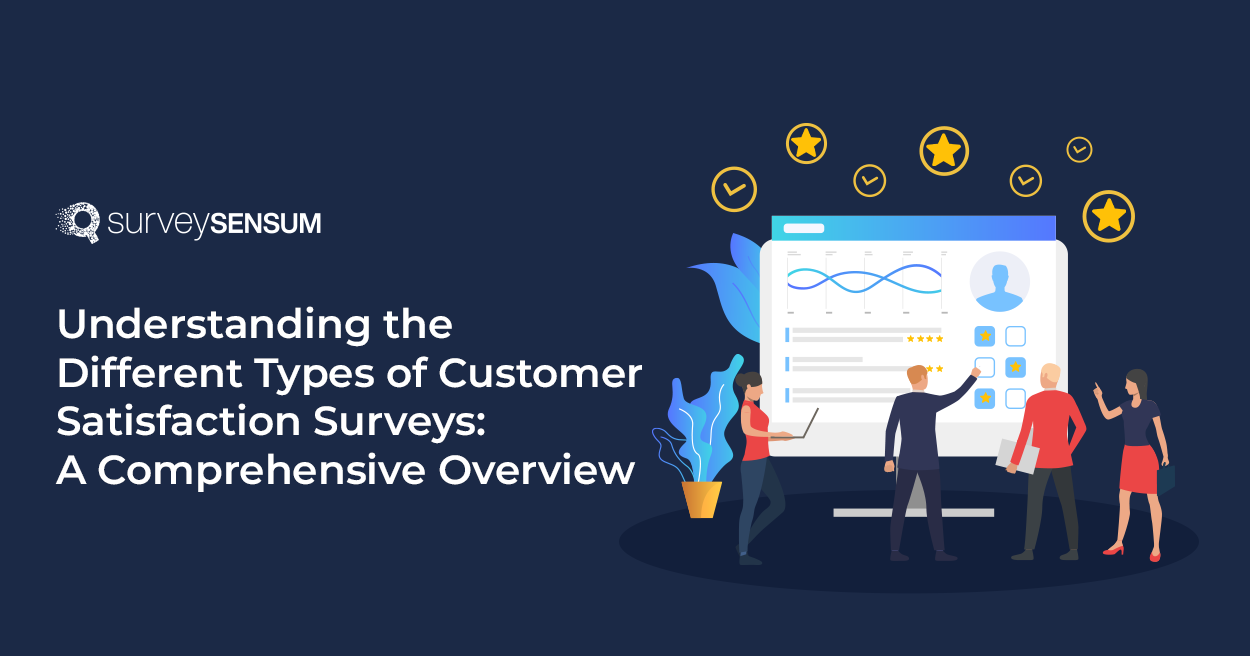
Imagine you just got a product you ordered online, and in just 10 minutes after the delivery, you received an NPS survey asking about your likelihood to recommend the product.
You’ve not even opened the product yet so, how can you recommend it to someone?
What’s more – instead of asking about your satisfaction level with the delivery of the product, they are asking about the recommendation.
Isn’t it weird?
I’m sure you don’t want this to happen with your customers as this is an important feedback touchpoint, and not getting it right is just a missed opportunity.
That’s why it’s crucial to launch the right types of customer satisfaction surveys at the right time.
So, what to do in such a scenario?
Launch a CSAT survey asking, ‘On a scale from 1-5, how satisfied are you with your delivery experience?’ Asking this question helps you gauge their delivery experience, which in turn helps you improve it and enhance their experience with the brand.
But that’s one case. How to choose the right kind of customer satisfaction survey at different touchpoints?
Let’s get into it!
A customer satisfaction survey is used by businesses to collect customer feedback about their experiences with products, services, or interactions with the company. It includes questions about overall satisfaction, and specific aspects of the experience (like product quality, customer service, or website usability), and also gathers suggestions for improvement.
The goal is to understand how satisfied customers are and identify areas where the business can enhance the customer experience.
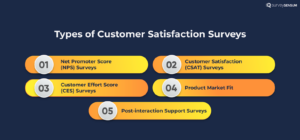
Here are the 5 types of customer satisfaction surveys that you can use at different touchpoints across the entire customer journey.
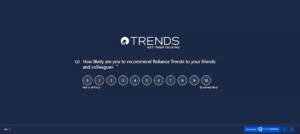
Net Promoter Score (NPS) surveys are the widely used survey to gauge customer loyalty on an 11-point scale. The respondents of the NPS scale are divided into three categories, Promoters (9-10), Passives (7-8), and Detractors (0-6).
→ Read further to learn about the right NPS questions to ask!
NPS surveys measure your customers’ likelihood of recommending your product and services to their friends or colleagues. This can lead to spreading good word of mouth – branding your business, and increasing customer loyalty, satisfaction, and overall experience.
How to Calculate NPS?
To calculate NPS, subtract the percentage of Detractors from the percentage of Promoters.
NPS= Percentage of Promoters−Percentage of Detractors
Example:
NPS = 60% − 20% = 40%
So, the NPS in this example is 40%.
→ Read more about how to calculate NPS the right way!
Reap the various benefits of NPS with SurveySensum and launch your surveys today!

CSAT surveys aim to measure customer satisfaction based on their experience with your products and services. This survey can be asked on a 1-5 or a 1-7 point scale ranging from least satisfied to highly satisfied.
→ Read further to know about the right CSAT questions to ask!
With CSAT surveys, you can get insights into customer satisfaction levels, helping you identify areas of pain points and improvements. This will help you to make informed decisions, enhance customer experiences, and build strong relationships with your customer base.
The formula to calculate CSAT is:
(Number of satisfied customers (4 and 5) / Number of survey responses) x 100 = % of satisfied customers
Example:
You conducted a CSAT survey and received 50 responses. Among these, 35 customers rated their satisfaction as either 4 or 5.
Number of satisfied customers = 35
Total survey responses = 50
Percentage of satisfied customers= (35/50) × 100 = 70%
So, in this example, the CSAT score would be 70%.
→ Read further to learn how to calculate your CSAT score!

With Customer Effort Score (CES) surveys, you can measure how much effort your customers are putting into using your product or service to achieve their desired outcomes.
→ Read further to know about the right CES questions to ask!
CES surveys highlight pain-point areas where your customers find obstacles in their interactions. By resolving those areas you can reduce their efforts leading to enhancing their experience, increasing satisfaction, and ultimately improving customer loyalty and retention.
To calculate the average score, add up all the individual scores and divide by the total number of responses to get the average score.
Example:
Suppose you received the following CES ratings from 10 customers on a scale of 1 to 5:
Total Score = (3×4) + (4×3) + (2×5) + (1×2) = 12 + 12 + 10 + 2 = 36
Average Score = 36/10 = 3.6
So, the CES score in this example would be 3.6.
→ Know more about how to calculate CES efficiently!

Product-market fit (PMF) describes the alignment between your product or service and your targeted market. It determines the success and viability of your product in the market.
If your product achieves a strong PMF, it means it resonates with the target market, meets its expectations, and addresses its pain points effectively. This alignment leads to increased customer acquisition, satisfaction, and loyalty, ultimately driving business growth and profitability.
So, strike a chord with your customers to gauge the level of alignment between your products and the market’s demands.
If your product achieves a strong PMF, it means it resonates with the target market, meets its expectations, and addresses its pain points effectively. This alignment leads to increased customer acquisition, satisfaction, and loyalty, ultimately driving business growth and profitability.
So, strike a chord with your customers to gauge the level of alignment between your products and the market’s demands.

Would you like to analyze the efficiency of the customer support team?
This is where post-interaction support surveys come in. These surveys are asked from customers after a support call to gather feedback on the quality and experience. It also focuses on the customer’s experience with the company’s frontline representatives, support teams, or specific service delivery.
Conducting this survey will enable you to assess the effectiveness of your customer service. By collecting feedback on individual interactions, you can identify what went wrong and what you should continue doing, and improve the overall customer experience.
→ Read more about the strategic impact of the journey-based csat survey!
This was all about the different types of customer satisfaction surveys that you can launch at different touchpoints in your entire customer journey.
But do you know there are different types of scales used to launch customer satisfaction surveys?
Now that you know all the different types of customer satisfaction surveys, why wait? Deploy them all in under 5 minutes with SurveySensum!
Free Forever • No Feature Limitation • No Credit Card Required • Get a Live Demo
Now that you’re here, let’s quickly look at the uses of different types of scales with examples to understand them better.
A binary scale is one of the easiest scales that offers only two options to respondents i.e., either ‘yes’ or ‘no’, ‘true’ or ‘false’, etc. It is a straightforward and simple survey scale that allows respondents to provide a direct and concise answer.
For example
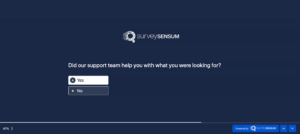
A rating scale is another type of survey question that asks respondents to rate their feedback or experience on a predefined scale. The 1-5 point scale ranges from low to high or from disagree to agree, offering multiple response options that allow for a more nuanced answer.
Example:

The Likert scale is a popular survey question that ranges from 1-5 or 1-7 point scale from lower to higher. It measures the customer sentiment on whether they ‘strongly agree’ or ‘strongly disagree’ with the given question.
Example:

An open-ended question is a must in all surveys because it gives customers a free space to give detailed feedback or suggestions about their experiences with your business in their own words.
Example:
With all these customer satisfaction surveys, you can ace your business and delight your customers.
Ask your customer what you need to know in the most effective way with engaging surveys using SurveySensum!
Free Forever • No Feature Limitation • No Credit Card Required • Get a Live Demo
But wait.
Do you know how to create a customer satisfaction survey?
Here are 4 steps to create your CSAT surveys:
STEP 1: Sign up for free on the SurveySensum website.
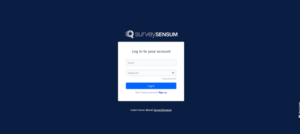
STEP 2: To create a survey, choose customer satisfaction survey aka CSAT survey in-built template.
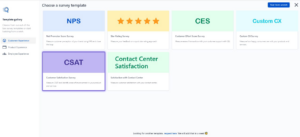
STEP 3: Personalize the in-built template as per your business’ branding and targeted customers and click on the shared survey.
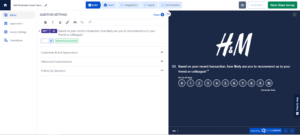
STEP 4: Share surveys on those channels where your customers are present. Most businesses use WhatsApp surveys nowadays because it’s inexpensive and effortless.
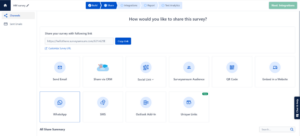
STEP 5: After creating and shooting the surveys in only four steps, you can analyze the gathered feedback with the in-house AI bot Text Analytics Software of SurveySensum.
Here, our journey of customer satisfaction surveys comes full circle, so, let’s sum up.
Collecting customer feedback using CSAT tools is essential but not enough, what actually matters is what you do with it. Here are some strategies on how to take action on customer feedback:



By following these steps, you can ensure that customer feedback is acknowledged, acted upon promptly, and closed with satisfactory resolutions, leading to improved customer satisfaction and loyalty.
→ Create an effective customer satisfaction strategy with these tips!
In conclusion, having a comprehensive understanding of the different types of customer satisfaction surveys can empower your business to effectively measure and improve customer satisfaction.
Whether it’s NPS, CES, or CSAT surveys, each type offers valuable insights into customer experiences. By using these surveys strategically, you can identify areas for improvement, close the loop, and drive overall success.
To easily create and deploy these surveys, try SurveySensum, an efficient customer satisfaction software that allows you to effortlessly design and analyze customer satisfaction surveys.
Free Forever • No Feature Limitation • No Credit Card Required • Sign Up For Free
1. What are the seven Different Ways of Measuring Customer Satisfaction?
Customer satisfaction surveys are instruments utilized by companies to collect input from customers regarding their interactions with products, services, or engagements with the organization. These surveys usually inquire about general satisfaction levels, and particular facets of the experience, and may solicit suggestions or comments for enhancement.
3. What are the 5 basic levels of customer satisfaction?
The five basic levels of customer satisfaction are:
The three types of customer satisfaction are:
